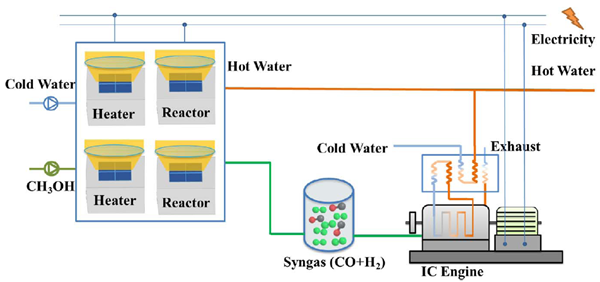This study proposes an efficient, flexible and low-carbon combined heating and power (CHP) system with solar energy and methanol as energy inputs. The system features a modular design combining concentrated photovoltaics, methanol thermochemistry and internal combustion engines that enable efficient power generation, effective energy storage and flexible, demand-driven supply of heat and power. Cascaded utilization of solar energy results in a high net solar-to-electric efficiency of 38.9%, while tunable output flexibility of energy allocation between heat and power leads to both coal saving ratio and CO2 emission saving ratio in a wide range between 16.9% and 100%. Effective solar energy storage via methanol-derived syngas enables off-sun operations under normal energy demand conditions up to a few days, and attains round-the-clock heat supply with 41% carbon consumption and CO2 emission savings. The proposed system showcases a practical and efficient means of solar energy utilization complemented by fossil fuels, and provides a potential solution towards imminent energy and environmental challenges worldwide.
Conclusions
We proposed a combined heating and power (CHP) system integrating concentrated photovoltaics (CPV), methanol thermochemistry and a cogeneration part with internal combustion engines (ICEs), for the purpose of addressing challenges associated with fossil fuels and solar energy utilization. The energy demand-driven CHP system is designed to operate under three modes to satisfy typical energy demand from different users or single user’s side under different scenarios: (1) Supply heat and power directly from PV cells; (2) Supply heat from ICEs and power from both PV cells and ICEs; (3) Supply heat and power from both PV cells and ICEs. Analysis shows that in Heating Mode, the CHP system achieves a solar utilization efficiency of 72.8% and emits zero CO2 but cannot store energy; in Reaction Mode, owing to cascaded solar energy utilization and synergy between solar energy and methanol, high net solar-to-electric efficiency of 38.9%, high solar exergy efficiency of 46.4% and high standard-coal and CO2-emission saving ratio of 16.9% can be achieved; in Heating & Reaction Mode, the complementation between heat output from PV cells (carbon free) and ICEs (on-demand, via energy storage) affords a low-carbon (coal consumption and CO2 emission both 41% lower than the traditional system) heat supply capability that meets users’ energy demand around the clock. The flexible energy supply, high efficiencies, outstanding energy savings and emission reduction performance of the proposed system provide a promising means of clean and green cogeneration of heat and power for a wide range of applications through the integration of considerable portions of solar energy into fossil-fuel-based CHP systems.
The results have been published on Applied Energy 206 (2017) 1523-1531.

Fig.1. Schematic of Sys.1 with a solar energy collection & utilization part and a cogeneration part based on internal combustion engines for heat and power cogeneration.